What Is a Media Kit? How to Create One for Podcasts
A media kit is a chance to make a good first impression. It’s like introducing yourself to somebody you haven’t met before. It’s their first look at you — so you want it to be snazzy — and pretty.
We know you’re not supposed to judge a book by its cover, but if something’s got cover appeal it’s more likely to catch your eye.
Attention spans are dwindling.🐠
When someone tunes into your podcast, you have 30 seconds, maybe a minute, to reel them in. Podcast media kits work the same way. They need to stand out and make an impact — quick.
So, how do you make your media kit attractive to attract sponsors/guests? What should it include? Podcast pitch emails: What should they contain? Which format is most appropriate — PDF or link?
This article provides straightforward answers to these questions and more.
Table of Contents
- What is a Media Kit?
- What is a Podcast Media Kit?
- Media Kit Uses
- Media Kits in Podcasting
- Benefits of Having a Media Kit
- Media Kit Examples
- What to Include in a Media Kit?
- Tools to Create a Media Kit
- Expert Tips for Podcast Pitch Emails That Get Responses
- Podcast Pitch Email Example
- Podcast Pitch Email Template
- Media Kit Format: PDF or Link, Which Is Better?
- 5 Big Don’ts of Media Kit Pitching
What is a Media Kit?
Media kits are promotional tools to pitch products and services to the media. Typically, they provide an overview of your brand’s story and key selling points.
It’s like the pitch PR professionals send to journalists and editors. Media kits give the people receiving the information they need to write a story about a company or product.
These kits can be a downloadable PDF, link, or even saved in the cloud, like in Google Drive or Dropbox folders.
What is a Podcast Media Kit?
A podcast media kit makes it easy to pitch your podcast to others — helping you grow your audience. In addition, it can address questions potential guests, hosts, or sponsors may have — minimizing the number of emails you receive from them.
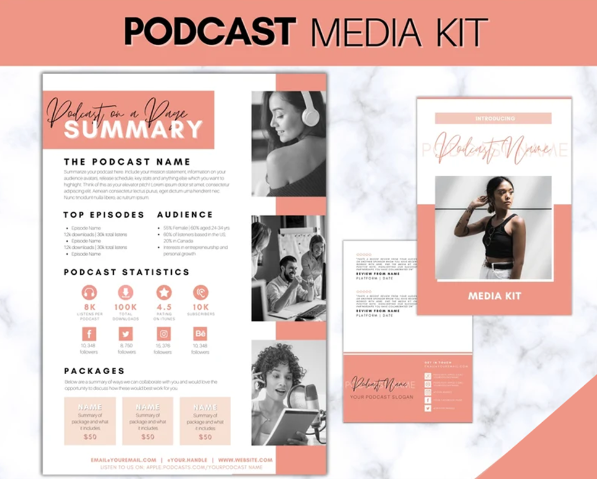
You can find templates like this one on sites like Etsy, or if you can build your own in tools like Canva or Affinity Designer.
Media Kit Uses
You can use them to:
- Book guest appearances
- Guest swaps
- Attract advertisers, investors, and sponsors
Media Kits in Podcasting
- Serve as an online version of a podcast pitch
- Market your podcast and help listeners find it
- Make your podcast stand out from the rest
- Contain all the information about your podcast a listener/future guest would want to know
- Create relationships with sponsors and open doors to monetization
Benefits of Having a Media Kit
Adding value
When you apply for a job with a resume, you should tailor your resume to the job opportunity and — pepper it with keywords from that job description.
Not only to show value but to emphasize you have the skills and experience the company is seeking. You’re showing you understand what they need and how you can help them achieve their goals.
Building a real human connection
Going back to the resume example — When you tailor your resume to match the job description— Why are you doing that? To affirm you have the skills and experience the company needs.
But showing your personality behind a screen is hard. So instead, use your content to speak for you. For example, let’s say your podcast is about nutrition and the sponsor you’re interested in working with is an energy drink brand.
In your media kit, you can include links to show episodes that appeal to energy drink consumers.
Media Kit Examples
You’re designing a media kit and want to see some examples of the most impressive ones? We’ve got you covered! Here are the five media kit examples from a variety of industries.
- Canva press kit template
Being a popular design site, Canva hosts some media kit templates, both free and premium templates. You can start with a media kit template and tailor it for a podcast, or you can build from scratch.
Here is a modified template and some examples of info you can include:
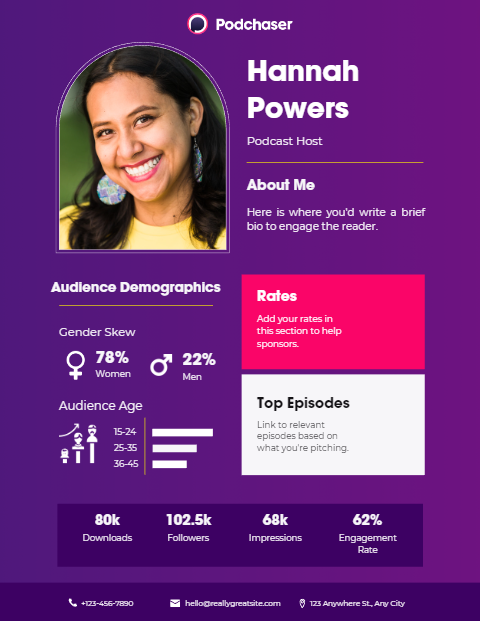
Expert tip: Add directional estimates of how many listeners a podcast has with Podchaser Pro.
- Conde Nast Traveler
- Digiday
- Gear Junkie
- Inc
What to Include in a Media Kit?
Your media kit speaks volumes about you. However, the information you provide doesn’t have to be exhaustive.
“In your media kit, you should include information such as page views, followers on social media platforms, growth, demographics of your audience, and location (these numbers can be gathered from Google Analytics, for example), main topics, guests/people interviewed, and contact information to demonstrate why investing in your business is a good deal.”
— Brett Robinson, Head of Content & Marketing for Wired Clip
The introduction is always essential — include your name, mission, and goal. Guests are curious about each key player’s role and how they got to where they are today.
Bio — Include a bio. If it’s a product, explain why it’s unique. If it’s a person, highlight what sets them apart.
Recent appearances — Include recent press releases and any pertinent product or marketing collateral.
Media appearances with links — Show your relevance and freshness by mentioning your most recent appearances. Of course, it’s okay if you don’t have anything recent. Put your past appearances there anyway.
Social media links — let kit recipients see your influence beyond the page and on social networks. It would help if you showed that you already have a following and are doing well.
“Links to your social media so a host can quickly check out how you show up and the degree to which you have a following of your own.”
— Podcast Guesting Success Expert Nancy Juetten
Images — Adding more than one image to a media kit makes life easier for recipients. They can choose the options that work best for them and their context.
Logos — These will enhance your credibility and professionalism. Don’t copy another podcast’s design; ensure your branding matches your podcast’s look and feel.
Professional images/ headshots — should be high-resolution visuals.
Metrics — Numbers matter. For example, if you have an episode with 10,000 listens, highlight that. Media kits are a chance for you to celebrate your wins.
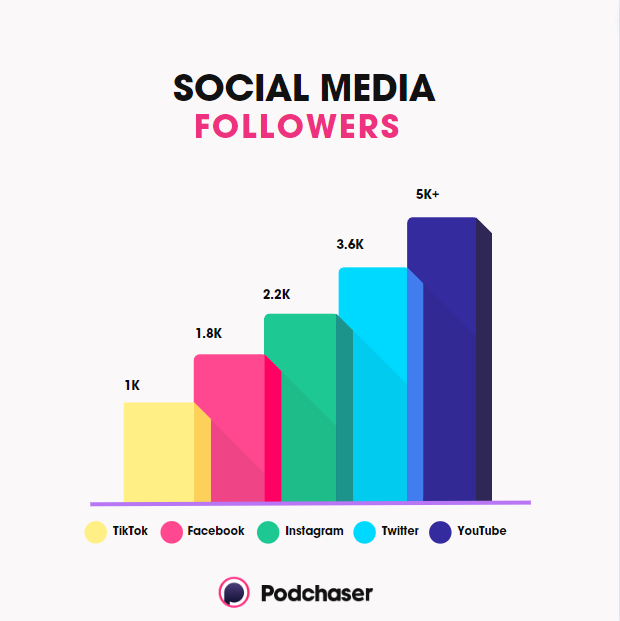
Visualize your data. Include graphs, such as bar graphs or pie charts. Using visual representations of numbers is an excellent way to convey your story in a quick, easy-to-understand way.
Other metrics include demographics, average sales revenue, conversions, and social media engagement.
Your work — List your podcast, guest appearances, and media coverage.
Rate card — Add your rate card if you want sponsorship; this will clarify your expectations.
Testimonials — Reviews, awards, and listener stats to show your expertise.
Always remember to update your media kit. Include recent testimonials, updated social follower count, reviews, case studies, and more.
Contact details — If you want people to reach out to you, make it clear. Think of this as your primary call to action.
Tools to Create a Media Kit
Creating a media kit can be challenging — especially if you don’t have design skills. Fortunately, there are several productivity tools to make life easier for podcasters — whether as guests or hosts.
Here are some tools for creating a media kit:
Canva
In 4 steps, you can create a kit on Canva.
1. Go to Canva and search for “Media Kit.”
2. Choose one of the ready-made templates or start creating from a blank page.
3. Edit your kit to suit your style.
4. Download or copy the link to share.
Template.Net
Template.net provides free, customizable sample media kit templates you can customize to suit your needs.
Other ways to create a media kit include:
Free plans are available for the media kit templates listed below; some even provide easy use of drag-and-drop design tools.
“If you’d like to share a template to make it easy and fast to create a media one sheet, Media One Sheet delivers the goods.”
— Podcast Guesting Success Expert Nancy Juetten
Expert Tips for Podcast Pitch Emails That Get Responses
Guests and podcasters can both benefit from a podcast pitch. However, a successful pitch requires the right ingredients, according to experts. So make this part of your next pitch to increase response rates.
Subject line
Your subject line should be interesting because it is the first thing they see. Thus, it determines the fate of your pitch.
A quick subject line tip is to mention something they just did. For example, Episode IV of your show was epic.
“The best practice for outreach pitch emails is to have a subject line that grabs the readers’ attention and makes them want to open it.”
— Sherese Patton, Founder and Principal Publicist of The Patton Agency
About your podcast
Depending on the podcast, this can be the start date, the end date, or the number of episodes released. It will significantly impact you by showing you can back your success/value with data.
“Email pitches are NOT the time to be humble. Instead, they’re your chance to show the person who the time and energy you’ve spent becoming the brand you are.”
— Podcast Expert Christina Marcello
Hooks
Help entice the kit recipient to read further and provide context for the information in the kit.
“I recommend posting a starred review on the platform where you heard the podcast, as well as capturing a screenshot of the review that you can showcase in your introductory message to the host. Hosts love it when potential guests do that.”
— Podcast Guesting Success Expert Nancy Juetten
Bring your copywriting instinct.
Persuasion plays an instrumental role in virtually every copy. While there’s no end to learning the skill of persuasion, you don’t have to reinvent the wheel. The internet is full of blogs about copywriting formulas.

“My formula is, ‘Problem—Solution—Formula.’ What problem do you solve for your audience? What three solutions can you provide? Give them solid nuggets of your expertise, actionable things to do.”
— Jill Lublin, Master Publicity Strategist
Always personalize your email.
You only have a few seconds to grab someone’s attention in cold emails. Personalized emails are a great way to do this.
There needs to be more than just mentioning the person’s first name. Instead, give the person a sincere compliment; this shows you genuinely care about their content and are not using them only to get your name out there.
“There is NO copy and paste in PR. I believe in getting personal with the host or journalist. This entails listening to an episode or two… reading their past articles… checking their social media accounts and website. It gives you an edge and means you’ve done your homework—you’re already a step ahead of many others.”
— Michelle Glogovac, THE MLG Collective
Check out these three copywriting tools for better PR pitches.
Show value first.
Using the host to promote your book isn’t going to land well. Instead, use your book to spark a meaningful discussion about a topic that matters to you, the podcast host, and their audience.
Be clear and concise.
Keep it short and sweet. Your goal is not to overwhelm the recipient with too much information but to delight them.

“Assume every editor or producer you pitch has an inbox that looks like a digital wasteland. Always do your research and make sure you’re pitching the right person — be brief — concise, accessible, and resourceful.”
— Senior Communications Director at Etched Communication, Asia Phua
Signature
Add your contact details and social handles. Establish your credibility as someone who can provide value. You may not get a chance otherwise.
Proofread
Make sure your email is error-free before sending it. There is nothing more unprofessional than an email filled with typos.
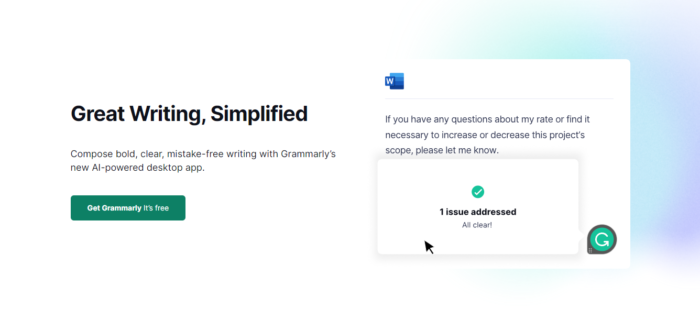
Follow-ups
This strategy works well, but you have to tread cautiously.
“Don’t pester people for answers. If the opportunity isn’t immediately time-sensitive, wait a week to follow up if you haven’t received a response. If that doesn’t warrant a response, wait a few days to send your third and final message, then close the loop and move on. For every rejection, there’s a potential bite lurking in the next office over.”
— Asia Phua, Senior Communications Director at Etched Communication.
Podcast Pitch Email Example
Now you know the anatomy of an effective cold email. Here’s a sample:
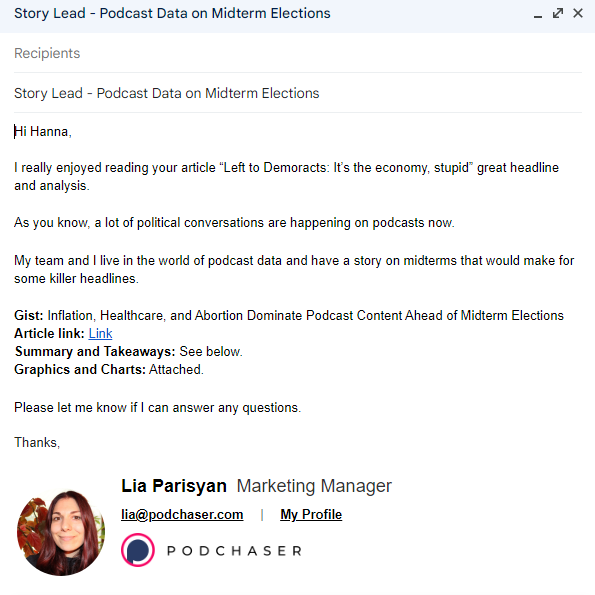
Podcast Pitch Email Template
Outreach emails can take a lot of time to write. Do you know how to leverage cold emails without spending all day writing them? Streamline your cold email outreach with this handy template:
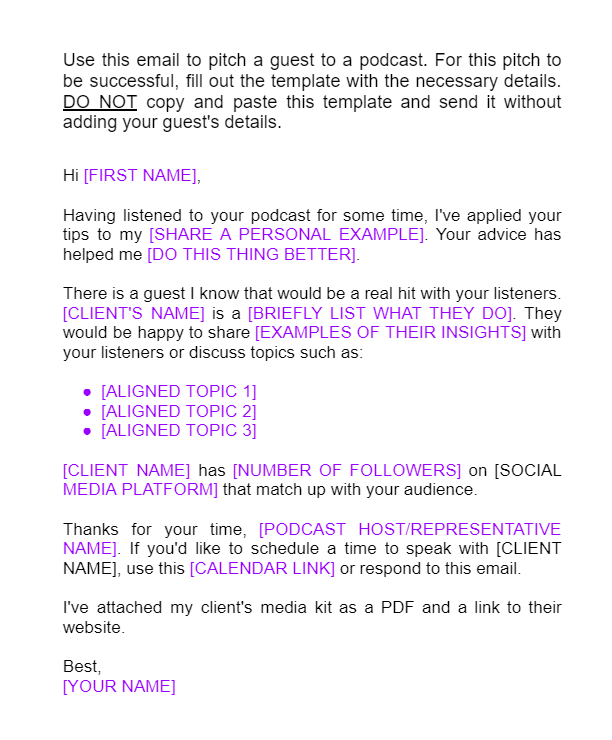
Media Kit Format: PDF or Link, Which Is Better?
Choosing a media kit format is an ongoing debate. So we created a poll based on the responses of the experts we interviewed. Here’s the result.
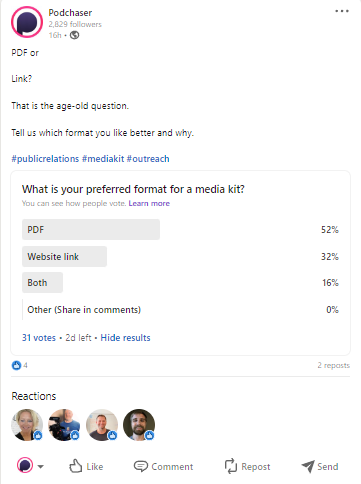
Advantages of sending a media kit pitch as a link:
Easier — “You can make people’s lives easier by sending them an online media kit because it’s easier for them to navigate,” says Christina Marcello.
For deliverability — Use links instead of PDF attachments in your pitch: Spam filters, anti-virus programs, and other programs may remove or block attachments. PDFs may not render well on mobile phones, causing the journalist to dismiss the pitch outright, says Maria Gonzalez.
Advantages of sending a media kit pitch as a PDF:
For attractiveness — PDF gives you a clean, high-resolution document to read, says Sherese Patton.
To save time — Send them as PDFs to avoid making recipients click a hyperlink and to make them more visually appealing, says Brett Robinson.
We recommend:
Links are helpful, and a well-designed PDF looks great. However, it is advisable to combine both formats. So attach the PDF file to the email and add a hyperlink to the media kit. In other words, let the recipient choose.
“I prefer a hyperlink, as it looks cleaner in an email to the writer. Because PDFs can be large, it’s possible for a recipient to overlook an attachment. A hyperlink stands out to shout ‘click me,’ so to speak.”
— PR Expert Kosi Harris
5 Big Don’ts of Media Kit Pitch
Sending a pitch to get guests or sponsors for your podcast requires effort. So, in any case, don’t do these five things:
1. Send your content without proofreading it.
2. Send a generic pitch.
3. Forget to update your [client’s] information
4. Send a wordy pitch.
5. Include a PDF or link to the media kit.
Media Kits Work — When Done Correctly
Woo, you just learned everything you need to know about media kits! How to send a pitch to get a response. What to include in your media kit — plus the five biggest don’ts.

Continue your journey by learning podcast tools to help make your life easier, and explore how Podchaser can help you grow your show.
Unlock more with Podchaser Pro
- Audience Insights
- Contact Information
- Demographics
- Charts
- Sponsor History
- and More!

- Account
- Register
- Log In
- Find Friends
- Resources
- Help Center
- Blog
- API
Podchaser is the ultimate destination for podcast data, search, and discovery. Learn More
- © 2024 Podchaser, Inc.
- Privacy Policy
- Terms of Service
- Contact Us